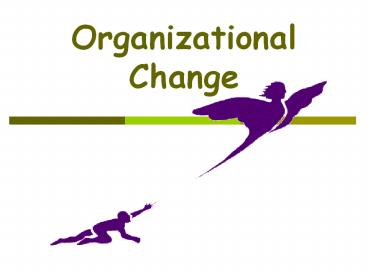Organizational%20Change - PowerPoint PPT Presentation
Title:
Organizational%20Change
Description:
Organizational Change What is Organizational Change? The process by which organizations move from their present state to some desired future state to increase their ... – PowerPoint PPT presentation
Number of Views:243
Avg rating:3.0/5.0
Title: Organizational%20Change
1
Organizational Change
2
What is Organizational Change?
- The process by which organizations move from
their present state to some desired future state
to increase their effectiveness
3
Workforce
World Politics
Technology
Forces For Change
Social Trends
Economic Shocks
Competition
4
- Rethink the most efficient ways to
- Use resources
- Disseminate/gather information
- Develop people
Changes in work relationships
Changing Technology
Changes in organizational structure
5
Increased Diversity
Changed values and expectations
Changing Workforce
Less unionized
More dual career families
More educated
Larger Contingent workforce
6
General Model of Planned Change
Evaluating and Institutiona- lizing
Planning and Implemen- ting
Entering and Contrac- ting
Diagno- sing
7
Different Types of Planned Change
- Magnitude of Change
- Incremental
- Quantum
- Degree of Organization
- Overorganized
- Underorganized
- Domestic vs. International Settings
8
Critique of Planned Change
- Conceptualization of Planned Change
- Change is not linear
- Change is not rational
- The relationship between change and performance
is unclear - Practice of Planned Change
- Limited consulting skills and focus
- Quick fixes vs. development approaches
9
Managing Planned Change
10
Lewins Change Model
Changing
Refreezing
Unfreezing
11
Lewins Change Model
Unfreezing - involves encouraging individuals to
discard old behaviors by shaking up the
equilibrium state that maintains the status
quo Moving - new attitudes, values, and behaviors
are substituted for old ones Refreezing -
involves the establishment of new attitudes,
values, and behaviors as the new status quo
12
Lewins Force-Field Theory of Change
- Theory of change which argues that two sets of
opposing forces within an organization determine
how change will take place - Forces for change and forces making organizations
resistant to change - To change an organization, managers must increase
forces for change and decrease forces resisting
change
13
Unfreezing the Status Quo
Desired State
Restraining Forces
Status Quo
Time
14
Force Field Analysis
Driving forces
Resisting forces
High perf. goals
Group norms for output
New equipment
Familiar equipment
Competition
Complacency
Need to learn new skills
Employees with new skills
Fear of reduced rewards
Desire for higher rewards
Current level of group performance
Desired level of group performance
15
Change Resistance Forces
Strong
Resistance Forces
Weak
Strong
Weak
Change Forces
16
Resistance to Change - Individual
Selective Information Processing
Force of Habit
Individual
Fear of the Unknown
Need for Security
Economic Factors
17
Resistance to Change-Organisation
Group Inertia
Threat to Existing Relationships
Structural Inertia
Organizational
Threat to Existing Allocations
Limited Focus of Change
Threat to Expertise
18
Employee Readiness for Change
Perceived Personal Risk from Change
Low
High
Moderate to indeterminate readiness
High
High readiness
Level of Dissatisfaction with the Current
Situation
Moderate to indeterminate readiness
Low readiness
Low
19
Overcoming Resistance to Change
Education and Communication
Participation
Negotiation
Facilitation and Support
Coercion
Manipulation and Cooptation
20
Organizational Culture
- the set of shared values and norms that controls
organizational members interactions with each
other and with people outside the organization
21
Components of Organizational Culture
- Routine behaviors.
- Norms shared by members.
- Dominant values.
- Guiding philosophy for policies toward employees
and customers. - The rules of the game for getting along in the
organization. - The climate of the organization.
22
Levels of Organizational Culture
Cultural Symbols
Shared Behaviors
Organisational Values
23
Organizational Culture
Functions
Liabilities
- Defining boundaries
- Conveying identity
- Promoting commitment
- Controlling behavior
- Impeding change
- Inhibiting diversity
- Blocking mergers
- Blocking acquisitions
24
Requirements for Successfully Changing
Organizational Culture
- Understand the old culture first.
- Support employees and teams who have ideas for a
better culture and are willing to act on those
ideas. - Find the most effective subculture in the
organization and use it as a model. - Use the vision of a new culture as a guide for
change. - Recognize that significant cultural change takes
time. - Live the new culture.
25
Issues to Address in ChangingOrganizational
Culture
- Capitalize on dramatic opportunities.
- Combine caution with optimism.
- Understand resistance to cultural change.
- Change many elements, but maintain some
continuity. - Recognize the importance of implementation.
- Modify socialization tactics.
- Find and cultivate innovative leadership.
26
Initiatives Contributing to Effective Change
Management
Motivating Change
Creating a Vision
Developing Political Support
Effective Change Management
Managing the Transition
Sustaining Momentum































